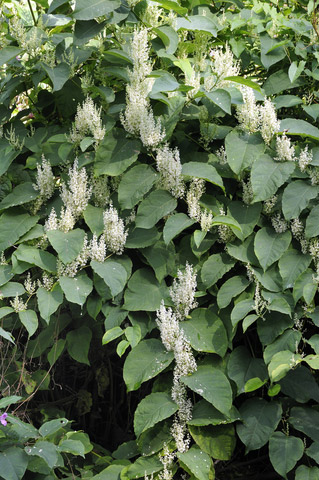Gardens
Japanese Knotweed | Garden Solutions
A tall, grassy plant we call “bamboo” has been spreading like wildfire near a brook on our property, and we can’t control it. We don’t want to use anything that will affect our water, wells, or wildlife. — P.D.S., Agawam, MA Polygonum cuspidatum, commonly known as Japanese knotweed or Japanese bamboo, was introduced from eastern […]

 A tall, grassy plant we call “bamboo” has been spreading like wildfire near a brook on our property, and we can’t control it. We don’t want to use anything that will affect our water, wells, or wildlife. — P.D.S., Agawam, MAPolygonum cuspidatum, commonly known as Japanese knotweed or Japanese bamboo, was introduced from eastern Asia in the late 19th century. It’s not a true bamboo; it’s an aggressive member of the buckwheat family. It takes over stream banks, forming dense thickets that crowd out all other vegetation. Its extensive, deep, brittle root system grows vigorously, tolerating shade, drought, brackish conditions, and high temperatures, and spreading rapidly in wet soils and adjacent areas.
Controlling this species without using chemicals requires perseverance. Digging out the plants with hand tools may control it if you’re persistent. But each root piece that breaks off has the potential to sprout again and grow into a new plant. This invader has become a pervasive and serious enough environmental threat that even most conservation groups agree that chemical controls are necessary. I know of no biological control.
Several herbicide formulations are available that, when handled properly, will cause minimal damage to animals, water, and other plants. You apply these chemicals to either cut stems or foliage, depending on the situation, and repeat treatments are usually necessary. Contact your local extension service or state fish and wildlife department for recommendations. And make sure you always follow the directions on the label. — R. Wayne Mezitt, Chairman, Weston Nurseries, Hopkinton, MA
A tall, grassy plant we call “bamboo” has been spreading like wildfire near a brook on our property, and we can’t control it. We don’t want to use anything that will affect our water, wells, or wildlife. — P.D.S., Agawam, MAPolygonum cuspidatum, commonly known as Japanese knotweed or Japanese bamboo, was introduced from eastern Asia in the late 19th century. It’s not a true bamboo; it’s an aggressive member of the buckwheat family. It takes over stream banks, forming dense thickets that crowd out all other vegetation. Its extensive, deep, brittle root system grows vigorously, tolerating shade, drought, brackish conditions, and high temperatures, and spreading rapidly in wet soils and adjacent areas.
Controlling this species without using chemicals requires perseverance. Digging out the plants with hand tools may control it if you’re persistent. But each root piece that breaks off has the potential to sprout again and grow into a new plant. This invader has become a pervasive and serious enough environmental threat that even most conservation groups agree that chemical controls are necessary. I know of no biological control.
Several herbicide formulations are available that, when handled properly, will cause minimal damage to animals, water, and other plants. You apply these chemicals to either cut stems or foliage, depending on the situation, and repeat treatments are usually necessary. Contact your local extension service or state fish and wildlife department for recommendations. And make sure you always follow the directions on the label. — R. Wayne Mezitt, Chairman, Weston Nurseries, Hopkinton, MA

